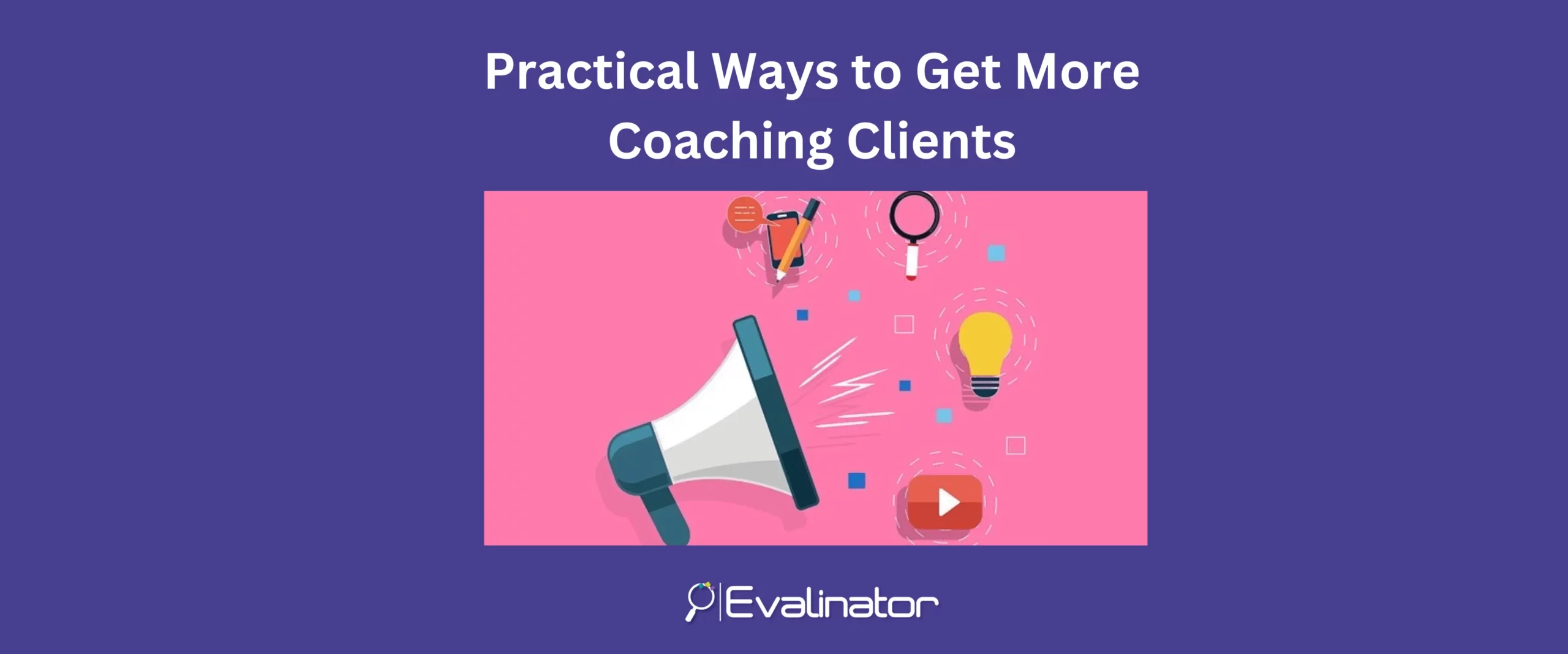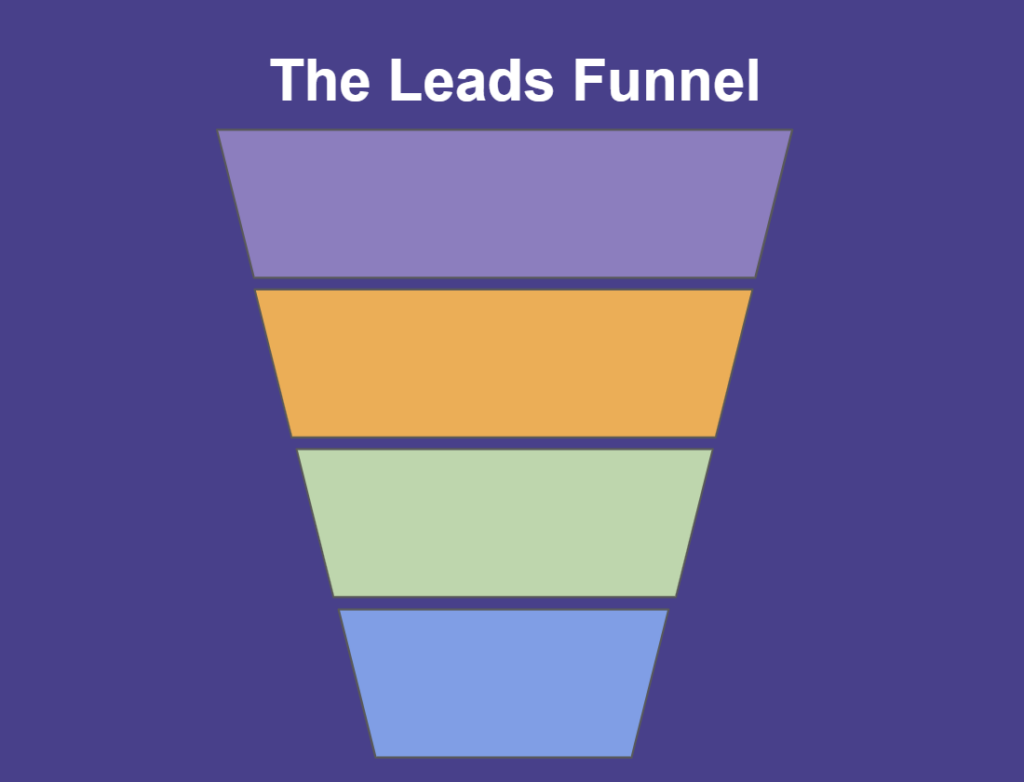


Every coach must have a plan to consistently get more coaching clients.
In this blog, we list 5 practical ways to help you do just that.
These strategies will yield results if you do them consistently.
Marketing and getting new clients in many respects is basically about:
Here are the 5 strategies we will present in this blog.
We’ll assume you already have a website and other basic things. If you don’t have them, then get started with that at the earliest!
This is one of the most important items in your growth plan.
You must promise and offer a “result”, not just a series of actions and deliverables. For example, Evalinator offers business growth and higher client retention, not just interactive coaching tools.
It does feel risky to promise a result, but ultimately everything comes down to following a proven process. Christie Mims of CoachPony explains this very nicely in her blog series on “people don’t buy life coaching”.
As a first step, define your offer and narrow down your target client audience as soon as possible. It is natural to resist narrowing your focus because you feel that you have so much to offer to everyone. But although it seems counter-intuitive, narrowing your offer actually makes it very powerful.
But how do you narrow your offer?
Once you have these items checked, then go for it.
This laser sharp focus will elevate everything about your marketing and positioning strategy. It’ll make your messaging crisper and your conversations more productive.
Once you have some traction, then you can worry about addressing important and adjacent customer segments. Slowly add additional personas as you pick up traction.
So, the first strategy to get new coaching clients is to develop a clear and focused offer that prospective clients can identify with.
It doesn’t mean you have to say goodbye to existing clients or avoid those who don’t fall into that narrow persona. You should continue to serve them because you will ultimately expand your market. However, in the short term you’ll be actively soliciting those who meet the criteria of your focused offer.
You’ll see this strategy pay dividends right away.

This is an important value exchange – offer something of value so prospective clients are more likely to give you their email address.
Think about it, prospective clients may love what you have to offer, but they may feel hesitant about setting up a strategy session, or get on a phone call with you. It feels daunting for various reasons. This post explains it well – is this happening on your website?
A lead magnet then becomes a soft landing and improves the probability of getting more coaching clients.
It is typically something that you offer on your website and also via other channels (e.g. in networking forum) in return for getting someone’s email address and their approval that you can stay in touch with them about your services.
A lead magnet can be as simple as a 1 page PDF or as complex as an entire ebook! We recommend starting with a simple lead magnet.
The first option is to create a simple checklist aimed at diagnosing a problem. If you are a career coach, ask people questions that help them understand why they may be falling behind. Keep it simple, and offer some insights at the end. It builds confidence and rapport. And prospects are likely to come back. Checklists are great and everyone loves them.
You can take your checklist to the next level by creating an online tool such as a tailored interactive Wheel of Life. It includes 8-10 key questions that prospective clients can ask themselves to do a self-check. No downloads are needed. It’s all online. As they complete the assessment, you can now give them personalized feedback in an automated manner.
In both cases, you now have their email address.
But, the big advantage of a digital Wheel of Life or another similar assessment is that you can not only provide value immediately, but you also gain important insights into the clients current state. It helps you initiate a highly personalized follow-up with them.
A lead magnet builds trust because you share your knowledge.
Visitors will be intrigued and will gladly provide their email address in return. Then you can follow up with them and invite them to your discovery session.
The advantage of doing this on Evalinator is that Evalinator is not just a quiz tool. It is used to take your clients on a journey, and helps you create a dialog based on your client’s goals.
You can get started with a free 14 day trial to create a digital Wheel of Life and see how it feels to you. Of course to be successful with it you will have to drive traffic to your website too – the other marketing strategies on this page should help with that.
Email and social media are often a catch-22 situation. It feels futile when you don’t have an email list and no social media followers.
But you have to start somewhere. And the best way to start is by putting together a high value content plan that will get you noticed.
Tip: See who some top influencers in your area of expertise are. Engage with them on their social media posts. Their followers (your potential clients) will see you, and they may click through to view your profile! It’s a good way to raise visibility. But remember to contribute positively if you are commenting on other people’s posts. The influencers may also share or like your content as a reciprocity gesture!
Chances are that you have a bunch of email addresses gathering dust in your inbox and on the business cards in your drawer. You may have gotten them from events that you attended, networking sessions, or from friends and family.
Create a list of these email addresses, along with at least the first name. Then begin to send periodic emails to this list (put everyone in bcc to maintain privacy). You can start with once a month and then work up to a higher frequency. The topics will range from general advice to stories (anonymized) from your coaching experience.
Here’s a nice post to create a storytelling framework for your emails. Everyone loves to hear stories of how other people overcame their struggle. Be sure to sprinkle in some of your coaching best practices as well to make them unique to you.
If you create a digital coaching wheel or another assessment, all of this becomes even easier for you.
Every topic in your Wheel is an email topic. For example, a typical wheel has 10 topics – family, career, hobbies, giving, friends etc – that must be in balance for someone to lead a fulfilled life. Each of these topics is something you can write on, and then you add in the interactions between them! Your digital wheel of life also comes integrated with several email providers. It’s a good idea to use one of those for email as you get started but it’s optional. Just like going to the gym, it’s often better to set up a routine and only then pay for the subscription.
In your emails, don’t forget to add links to your lead magnet. Also add a request that your recipients share your emails with others, and on social media.
Using these simple and practical items, you can increase your reach significantly.
Remember, consistency is key, and building trust and confidence is vital.
Now that you have the foundations all set up, it’s time to list yourself on expert directories.
There are several coaching directories such as Noomii, which allow you to list your services. These services generally have their own marketing engine running to get prospective clients to visit their site and search for coaches. They generally do a great job matching coaches to clients based on various criteria. So they becomes an excellent channel for you to increase your visibility and reach.
Be sure to include a link to your lead magnet (checklist or digital assessment) on your directory profiles.
Remember your offer is not to offer coaching, it is to give your clients a result. So keep that in mind as you write your profile description.
Most directories will offer a free plan so if available it’s better to start with that first to get a feel for the experience before signing up for a paid package at the one you like best. Paid packages may include direct links to your website, videos, and dedicated pages on the directory.
External reinforcement is when others talk about you and link to you. This is the toughest part of your marketing plan because a lot of this is outside your control. But you can approach this systematically.
With a little bit of work, you can amplify your marketing impact.
Build external reinforcement helps you in 2 ways: It helps you be more visible to people looking for advice (your prospective clients), and it increases the number of backlinks to your own website thus increasing it’s Google search presence. The latter will probably not be big game changer but every little bit will help – especially when people search for something that is unique to you.
There are probably many more ways you can get more coaching clients. But we felt that these 5 marketing strategies will deliver the most benefit in the short term with a reasonable amount of effort.
After all, you want to sell and market as a credible expert. So, as we mentioned before, marketing in many respects is about
a) building confidence and trust
b) increase awareness of your services.
Each strategy in this article addresses these aspects.
We wish you the best. If you create a digital assessment, we’ll be here to help you every step of the way. A digital assessment is the scalable way to start because it acts as a quiz for lead generation and also continue towards deeper prospect and client relationship management.
There’s a free trial for 14 days so go for it!

Feeling frustrated with lead generation?
Take this free, 5-minute quiz and get more prospects into your leads funnel.
Instant Results. Actionable recommendations. Email required.
Find Your Score >>